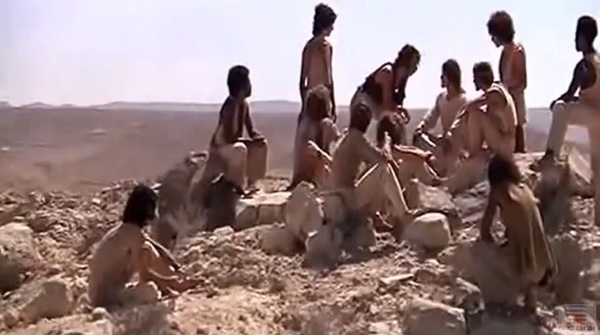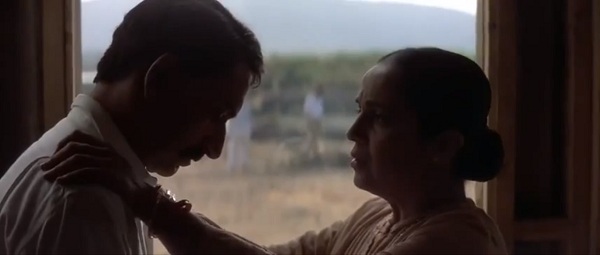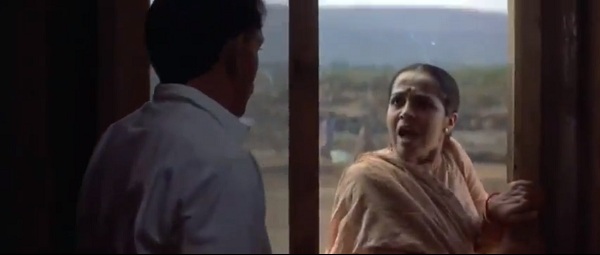Sarah Mendelsohn
Nailed at the Door
ISSUE 19 | DROUGHT | AUG 2012


Sharing is a privilege, but also something that we do all the time.
In his talk “Inspiration and Muses,” Jan Verwoert notes that we have long thought of the inspired artist as someone stricken with self-doubt. He evokes an allegorical artist: Jesus in the desert, a perennial student, as well as a perennial teacher. Verwoert’s artist needs to remove himself from social life in order to be at the center of a new social life; in order for his muses to find him, there cannot be anything else around. And then once they find him, he’s surrounded. His virtuosity as an inspired artist hinges on his spiritual precarity in the desert. If the muses don’t show up, Jesus is actually just alone. Making work in the desert, drought is always a possibility—without contact we will dry out. Drought is the worst-case scenario, the caricature of artistic withdrawal. In the deserts of our anxieties, and of our inspired studio lives, we prepare our work for a public. We anticipate the translation of these private feelings. But the model Verwoert proposes for understanding inspiration is not so clearly directional; what if the public we anticipate when in private is a public who meets us halfway? The doubt is not directed at the eventuality of the public, but at ourselves. Marina Abramović has recommended the desert as a solution to the insufficient public life of work created within a studio-based practice, and many others have expressed similar ideas: the studio is stuffy, the desert is hot and open. It’s appealing to think about the body exposed and vulnerable, and that this could be a place to connect powerfully with inspired feeling. This could be a starting place for making work.
But I read the desert image in Verwoert’s talk as identifying a helpful ambiguity: the studio is a site of both solitude and social anxiety, in which to invent a new way of reaching out, and of sharing. Creative life takes place in non-spaces, navigating between the course of inspiration and the value of privacy, and the privileged anxiety of sharing. Maybe the studio itself is already a desert, and is also a desert among deserts: a place among other places in which we are exposed.

At the center of a social life: holding studio visits in the desert.
Verwoert proposes that we take seriously the anxiety that accompanies anticipated moments of inspiration, suggesting that the potential artistic energy generated within the elusive shifting between anxiety and inspiration is not only creative, but social. When from outside those more loaded moments, we think of ourselves as inspired, we invest in an image of our creative potential as deeply individual, and deeply specific. But not necessarily so straightforwardly withdrawn—whether or not the actual things and people who move us feel impossible, or unlike the things and people who move anybody else, when we are moved to make work it involves a back and forth. For the past few weeks I have been stuck on the question posed by Verwoert: What kind of social space opens up in the moment of inspiration? What does this have to do with the vulnerability of any artistic practice that invests in a studio life, or wherever we do what we do privately; how do we invest in our inspiration as an arena of shared possibility? In his talk, Verwoert discusses this in terms of institutional life, such as the art school or the residency, as spaces in which to weigh the freedoms and restrictions of a socialized artistic life as both troubling and mutually generative. Building on Verwoert’s associational thinking, I think it is useful to consider the negative spaces around these spaces: the boring, mundane chores and labors that get integrated selectively into narratives of artistic collectivity or self-reliance, as well as parallel experiments in community and practice that do not necessarily make it into the self-analysis of contemporary art.
Chicago-based painter Molly Zuckerman-Hartung has written that the activity of painting might be as banal as washing dishes, as lingering with your hands in the dishwater for an extra minute. Her argument is against class and against romanticism: painting doesn’t need to live outside a category of daily, democratic experience. Anyone can linger, anyone can wash dishes. But, not everyone with their hands in dishwater is a painter; Zuckerman-Hartung suggests that to be a painter is to be making paintings always, and even at the sink. In this picture, there is no end to our private lives. Inspiration is de-eventualized; making art is about working—and working should not be inflated beyond the modesty of doing chores. It has no place in a dire desert-studio situation, or a spiritual fasting exercise, where there are not even dishes to wash.

Gandhi impresses upon his wife that on the Tolstoy Farm, she too must wash the latrines.1
These associations frame my question, in response to Verwoert: what if the anxiety of inspiration is not that we anticipate having to share, and to present ourselves and our work, but that we are already sharing, and that we won’t be able to share enough? How can we share just the right amount, when it is likely that the thing we are in fact sharing is in part a product or an expression of our doubt?
Adjacent to the gallery in which Zuckerman-Hartung hung a group of paintings for her recent solo show at the Museum of Contemporary Art in Chicago was a wall-sized vinyl text piece: the artist’s 95 Theses on Painting.2 Under this heading, her list read as 95 numbered statements, alternately direct and dogmatic, and personal—as much about the difficulty of reading a cogent political argument in painting, as about the act of painting. (“15. The stakes of painting are both universal and personal.“) She questions how we can adequately express our critique, simultaneously maintain a serious painting practice, and trust that all of this is communicated.
Another moment within the same scene.
Zuckerman-Hartung approaches the problematic issue of working from a usefully opposite cultural context:
65. All work, including washing dishes, sewing clothing, devising advertising campaigns and building iPhones can be meaningful, but capitalism has chosen to segregate these practices into a hierarchy of value.
66. Work typically done by women, with the hands, is not valued.
67. Work done in factories, with machines and hands, now mainly in China, is not valued.
68. Work done in the home, such as washing dishes or raising children is not valued.
69. Work done on the farm with machines and hands, is not valued.
70. We do not value work because we do not value ourselves. And we regard the objects made and lived with as depressed, depleted mirrors of our sorry self-hatred.
The pairing of Zuckerman-Hartung’s paintings with her writing, as installed at the MCA, expresses both the relationship between the banality of social anxiety and potential artistic energy that Verwoert describes, and the anxiety about working and spiritual practice that we find in this scene between Gandhi and his wife. By setting up this pairing, she is framing the same questions, what if we are already sharing and won’t be able to share enough?
51. Painting is a strongly held position.
52. The purpose of holding a strong position is to offer open invitation to dissenting critical thought.
The relationship between work as a grungy, dirty barrier between socioeconomic classes and as an artistic, grounding exercise (and spirituality as an ongoing, rigorous internal process of self-criticism) was a model Gandhi took seriously, and one that I think Zuckerman-Hartung takes seriously as well.

Members of the Tolstoy Farm. Kallenbach, L, and Gandhi, R, are seated in the middle row, in the middle, 1910.
Tolstoy Farm was for Gandhi a place to imagine the social shape of his personal experimentation, and to act out the more personally challenging dimensions of his practice with the people around him, as Attenborough’s film pictures him doing with his wife. By framing the installation of her work with her punchy and varied manifesto, Zuckerman-Hartung resolves to make visible Verwoert’s trajectory of inspiration and anxiety. There is something confessional about her Theses, however consciously they account for the latent politics of static art objects, and the equally untenable sociality of museum installation. Each sentence serves as a caption, and as a group they become an extended footnote to the group of paintings. Both the Theses and the paintings are situated to work collectively, discouraging us from talking about any singular painting on its own, or any singular statement. Their confessional quality is even more clear reading them on a blog, with no paintings in sight, now that her show has come down. As vinyl wall text in the museum, however, their confessional quality felt more discursive, more pressing, and more complicated: the text work asserts the complexity of the artist’s studio life, that her studio life should be as evidenced as her paintings, but also may not be fully evidenced by the paintings alone. Zuckerman-Hartung doesn’t make performances, but paintings, and she doesn’t post her Theses on Michigan Avenue or on the steps of the MCA, but inside the museum, and next to her work. The unevenness of her statements, and their overwhelming placement next to her paintings, helps me understand the kind of neurotic sharing that happens in the studio, in the desert, or at the sink: these are spaces for generous ambiguity, and for an uncomfortable intimacy of internal translation.
I have so many intentions. I know that I will attend to some more rigorously than others but still catch myself worrying about unevenness. Is this a starting place for making work, or is it just part of identifying as working? Some of my intentions will get played out in the studio, some I will act on somewhere else, whether or not I post notice, or write about it at all. I live in a desert, but right next to a lake. All summer I carry a bathing suit with me everywhere, just in case. 
1 Built on land purchased by Gandhi’s good friend and collaborator Hermann Kallenbach near Johannesburg in 1910, Tolstoy Farm was the site for Gandhi’s experiments with cooperative lifestyle, vegetarianism, and self-reliance, formative for the second phase of satyagraha in South Africa, 1908-1914. Having read Leo Tolstoy’s The Kingdom of God is Within You, published in 1894, Gandhi was stirred by Tolstoy’s Christian anarchism and his ideas about peace, and initiated a brief letter correspondence with the Russian writer between 1909 and 1910. Gandhi and Kallenbach’s residence was named a few months before Tolstoy’s death in November 1910. Day-to-day life on the ashram was structured around a series of spiritual and housekeeping exercises, and every morning began with chores.
Gandhi wrote about his efforts at the Tolstoy Farm, about his readings, and about his correspondence with Tolstoy in both Hind Swaraj and his autobiography.
This scene in Gandhi (dir. Richard Attenborough, 1982, starring Ben Kingsley as Mohandas K. Gandhi and Rohini Hattangadi as Kasturba Gandhi) illustrates the domestic drama between Gandhi and his wife that took place within the context of Gandhi’s experimentation in South Africa. As he persuades his wife to overcome her socialized prejudice against cleaning the latrines, we understand how deeply the caste system has been assimilated into even the most progressive marriage in early 20th-century India.
2 Zuckerman-Hartung’s show (May 1-July 24, 2012) was part of the BMO Harris Bank Chicago Works series at the MCA. It was the artist’s first solo museum exhibition.
The Hypocrite Reader is free, but we publish some of the most fascinating writing on the internet. Our editors are volunteers and, until recently, so were our writers. During the 2020 coronavirus pandemic, we decided we needed to find a way to pay contributors for their work.
Help us pay writers (and our server bills) so we can keep this stuff coming. At that link, you can become a recurring backer on Patreon, where we offer thrilling rewards to our supporters. If you can't swing a monthly donation, you can also make a 1-time donation through our Ko-fi; even a few dollars helps!
The Hypocrite Reader operates without any kind of institutional support, and for the foreseeable future we plan to keep it that way. Your contributions are the only way we are able to keep doing what we do!
And if you'd like to read more of our useful, unexpected content, you can join our mailing list so that you'll hear from us when we publish.
